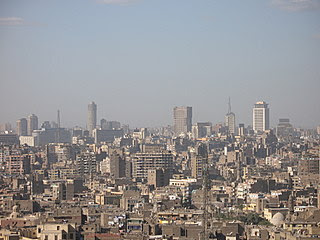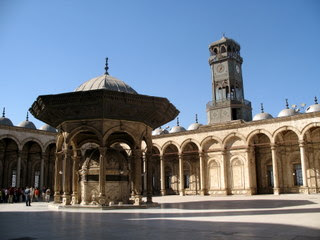
Words can't describe just how crowded and dense the living is in Cairo (and, I suspect, many other cities in India, China, etc.) I suspect there are parts of New York City or Philadelphia where things may be very tight, but we all reflected on the tremendous S-P-A-C-E we have in America! I don't think people who haven't been can imagine it. Certainly when we try to tell people (sometimes even Europeans) how long it takes us to drive from Minnesota to Montana, they can't believe the US is that big. It's equally hard to describe how the apartment buildings are less than 50 feet apart, 10-12 stories high, and go on and on and on...not to mention the little square houses. Everything sits on top of everything else.
Egypt is, of course, predominantly Muslim--about 80%. It used to be known as the "City of the 1,000 Spires" because of the minarets rising up from all the mosques. It is a beautiful sight, still, to look over the city and see the spires rising. The call to worship which is sung 5 times a day, also adds to the atmosphere (provided that the caller is any good!)

None of the churches allow pictures on the inside. We visited the Hanging Church, which had beautiful mosaics lining the courtyard. Built in the 9th century, it literally hangs suspended between 2 towers (a hole cut into the floor where you can see down to the ground proves it).

Egypt is, of course, predominantly Muslim--about 80%. It used to be known as the "City of the 1,000 Spires" because of the minarets rising up from all the mosques. It is a beautiful sight, still, to look over the city and see the spires rising. The call to worship which is sung 5 times a day, also adds to the atmosphere (provided that the caller is any good!)
We visited the mosque of Mohammed Ali (really) which is located inside the Citadel. The Citadel was begun in the 1100's to protect the city against the Crusaders. The British used it during World War II as a military compound as well. The mosque was built in the 1800's. From other pictures, I don't think it is the most beautiful mosque, but it was very impressive.
The courtyard was beautiful, and as far as I could go dressed in capri pants and a t-shirt. I had to put on a baggy green cloak-like thing that made me look like I was going to a 3rd rate Lord of the Rings convention. Sadly, no pictures available of that.
The interesting thing about mosques is that they're empty on the inside. I assume that during their services it fills up, but it was mostly tourists in the morning. I did see a number of men praying along the walls--women worship seperately. The mosque was as big or bigger than any cathedral, but the lack of pews made it feel somehow unfinished. We had to remove our shoes and weren't even allowed to put them down, as we discovered when Cameron set his down to get his camera.
Mohammed Ali (OK, and just to be clear, because someone's going to think it, it's NOT the boxer) is buried in a marble tomb at the mosque. As with everything else Egyptian, the carving was exquisite. The tomb is behind panels of beautiful wrought-iron work, with spaces just big enough to squeeze a camera in for a shot.
Mohammed Ali (OK, and just to be clear, because someone's going to think it, it's NOT the boxer) is buried in a marble tomb at the mosque. As with everything else Egyptian, the carving was exquisite. The tomb is behind panels of beautiful wrought-iron work, with spaces just big enough to squeeze a camera in for a shot.
Of the remaining 20% of the population, about half of them are Coptic Christians. At one time there were more than 20 Christian churches in less than 1 square kilometer; surrounding part of the area is a Roman wall built in the 2nd century. According to tradition, Coptic Christianity was established by the apostle Mark.  For several hundred years after the death of Christ, Egypt was predominantly Christian, but by the 1200's Islam had taken hold. The faith is more similar to Catholicism than Protestantism. They have their own. You can read a short introduction about Coptic Christianity but it would take quite a bit of study to fully understand the differences.
For several hundred years after the death of Christ, Egypt was predominantly Christian, but by the 1200's Islam had taken hold. The faith is more similar to Catholicism than Protestantism. They have their own. You can read a short introduction about Coptic Christianity but it would take quite a bit of study to fully understand the differences.
 For several hundred years after the death of Christ, Egypt was predominantly Christian, but by the 1200's Islam had taken hold. The faith is more similar to Catholicism than Protestantism. They have their own. You can read a short introduction about Coptic Christianity but it would take quite a bit of study to fully understand the differences.
For several hundred years after the death of Christ, Egypt was predominantly Christian, but by the 1200's Islam had taken hold. The faith is more similar to Catholicism than Protestantism. They have their own. You can read a short introduction about Coptic Christianity but it would take quite a bit of study to fully understand the differences. 
None of the churches allow pictures on the inside. We visited the Hanging Church, which had beautiful mosaics lining the courtyard. Built in the 9th century, it literally hangs suspended between 2 towers (a hole cut into the floor where you can see down to the ground proves it).

After Jesus was born, an angel appeared to Mary and Joseph, telling them to flee to Egypt and wait there until the death of King Herod. This is the event that marks the beginning of Christianity in Egypt. St. Sergius is the church built over the cave where the Family is reputed to have stayed. One of the leaders of the church is said to have had a vision of the location in 500 AD. I personally am a bit suspicious of the veracity of the actual location, as I am about all the actual locations of so many of the places in Israel and Jerusalem. I think the Bible is purposely vague in order to avoid people either worshipping actual sites or shrines instead of God, and also to avoid the illusion of needing absolute concrete proof of everything. On the other hand, 500 AD is not all that long after something happened and it is possible to believe that as word of Jesus spread, people remembered stories from the past? Who knows. The actual shrine is out of sight under the church. An altar-type area is set up at the top of the stairs that lead down to the shrine.


The convent of St. George (St. George and the Dragon) is also located in the area. Cameron remembered the story and all the kids loved the carvings and mosaics of St. George besting the dragon.
Also located in the Coptic area is the oldest syngagogue in Eygpt. Ben Ezra Synagogue is in a church built in the 4th century and converted by the the rabbi for whom the synagogue is named. Supposedly this is where the prophet Jeremiah gathered the Jews after King Nebuchadnezzar destroyed the temple in Jerusalem. Next to the synagogue is a spring where Moses was found and where Mary drew water for her family. Given the history between Israel and Egypt, it was interesting to visit such an old syngagogue that has been left untouched by politics.
Also located in the Coptic area is the oldest syngagogue in Eygpt. Ben Ezra Synagogue is in a church built in the 4th century and converted by the the rabbi for whom the synagogue is named. Supposedly this is where the prophet Jeremiah gathered the Jews after King Nebuchadnezzar destroyed the temple in Jerusalem. Next to the synagogue is a spring where Moses was found and where Mary drew water for her family. Given the history between Israel and Egypt, it was interesting to visit such an old syngagogue that has been left untouched by politics.
We are continually in awe of the age of things here. Forget buildings constructed during the Revolutionary War. Forget a church built in the 1300's. There is so much history--Pharoahs, Muslims, Christians, Romans, Crusaders...I felt simulataneously overloaded and guilty for not knowing more about what we were seeing.







No comments:
Post a Comment